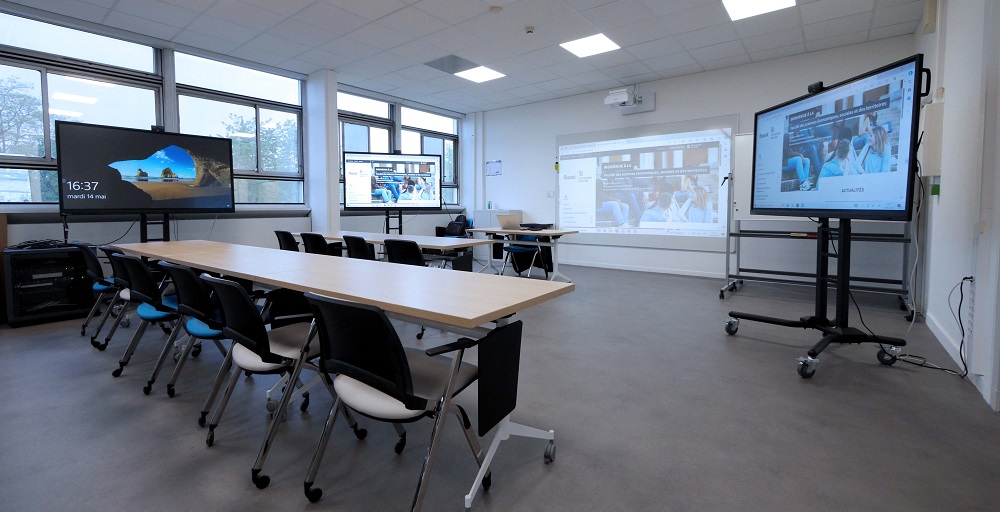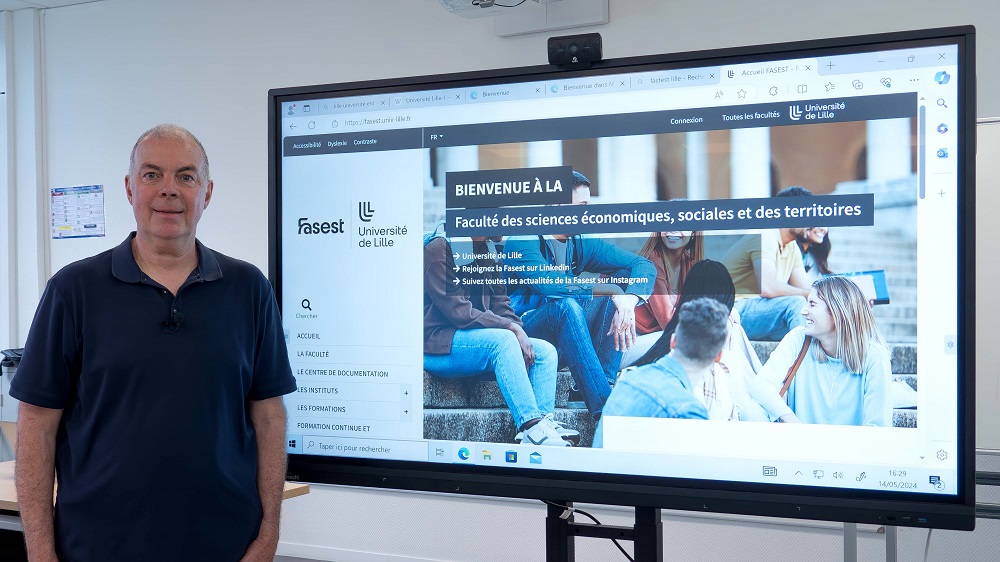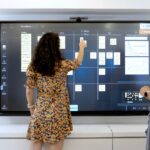Our camera visited the pedagogical innovation room at the University of Lille to interview Philippe Thoillier, who has been a trainer in the professional Banking and Insurance degree for 10 years after a 36-year career in the banking sector. Watch the full video testimonial.
A big thank you to Philippe Thoillier for participating in the interview and sharing with us his experience of using Speechi interactive screens in his classroom.
Video Extract #1: The evolution of teaching methods through the pedagogical innovation room
The 2020 Health Crisis: How to Teach Afterwards?
Just as the business world was profoundly transformed by the health crisis, integrating teleworking into its practices right after the confinement, a turning point occurred in education.
While some teachers returned to their pre-crisis habits with relief, others like Philippe Thoillier questioned their teaching methods in light of everything they implemented or learned during the lockdowns that forced the teaching community to conduct classes remotely.
“It allowed me to question myself and see how to capture students’ attention, how to convey information to them, how to create interactivity.”
Video Extract #2: Why integrate digital tools into teaching methods?
The Pedagogical Innovation Room:
A Classroom Unlike Any Other
Back in the faculty’s premises, the pedagogical team of the Banking and Insurance degree at the University of Lille, along with their pedagogical leaders Mr. Nedjar, Mr. Fajeau, and Mr. Clivio, envisioned a classroom where innovation would be the core and teaching would be different. The Pedagogical Innovation Room was born! It came to life in 2021 after a collaborative effort with Speechi.

Instead of a blackboard, this reimagined classroom is equipped with:
- 6 SuperGlass interactive displays
- Several SPE-MG-104 mini-conference cameras
- 1 SpeechiDisplay screen
And this unique learning environment has a clear pedagogical objective:
“Everything is brought together thanks to these touch screens to optimize the transmission of knowledge and the acquisition of skills.”
Video Extract #3: Presentation of the pedagogical innovation room
The Interactive Display: A Superb Course Design Tool
Early in the interview, Philippe Thoillier explains his daily use of Speechi interactive screens in his classroom to design his courses and engage students in an active learning process. He starts by mentioning two uses the most commonly expected from a connected digital board by the teaching community:
- Note-taking and drawing diagrams on the Note software, where everything can be saved, shared, erased, and redone. Discover the whiteboard software Note provided with the Speechi screen.
- Consulting various contents, ranging from distributing course materials (PowerPoint, PDF…) to web browsing and watching educational videos on YouTube with excellent display quality.
Focus on Quizzes: To animate his class and check the students’ understanding, Philippe Thoillier also uses two quiz applications: Kahoot and Wooclap. This is the key benefit of an ENI: being able to enhance and customize your digital board with pedagogical applications and software.
Focus on Role-Playing Games: To prepare his students for various professional scenarios, the trainer repurposed the small conference cameras atop each interactive screen in the class to set up role-playing games. He asks his students to play their future role as advisors in professional situations and films them using these cameras.
“When explaining the setup and opening of a bank account, I ask students to have one play the client role and the other play the advisor role. They conduct the interview as in real life at a bank, and I record it.”
Video extract #4: Interactive screen applications for preparing and delivering lessons
The Interactive Display at the Heart of Student Learning
The uniqueness of this pedagogical innovation room, let’s recall, lies in the fact that it is equipped with not just one but six interactive digital screens. The choice of such equipment stems from the pedagogical team’s desire to make the Interactive Display not the exclusive domain of the teacher but a tool available to students, placing them in an active learning posture during group work.

“The students really adopted these connected screens as a solution for acquiring knowledge.”
Training to Fully Utilize Interactive Display’s
Potential in Courses
As Philippe Thoillier reminds us, “the interactive displays are immediately usable,” and his students indeed adopted them without waiting for explanations. However, as a passionate educator, he aspires to deepen his use of the ENI and explore its pedagogical potentials. He is seriously considering taking more targeted training after an initial three-hour session with our trainer.
Having an interactive digital screen in the classroom means giving oneself the freedom to evolve one’s teaching practice by relying on a pedagogical tool that offers numerous possibilities.
Video Extract #6: From discovering basic tools to training for further advancement
Final Words: An Invitation to Evolve Teaching Methods with the Interactive Display
“The pedagogical innovation room should encourage all my colleagues. (…) We realize that the evolution of our teaching methods is quite rapid. That is to say, in 6 months or 12 months, we can completely question and optimize our way of teaching.”
Video Extract #7: Reevaluating teaching methods through the power of digital tools
To explore further:


